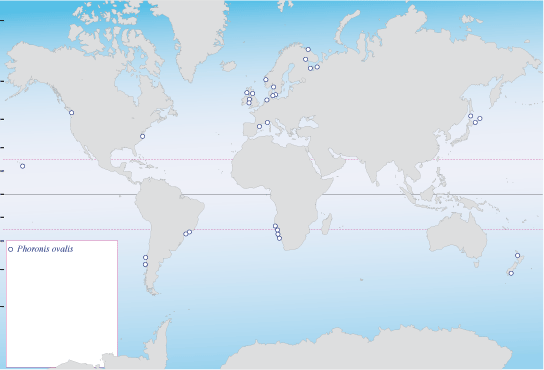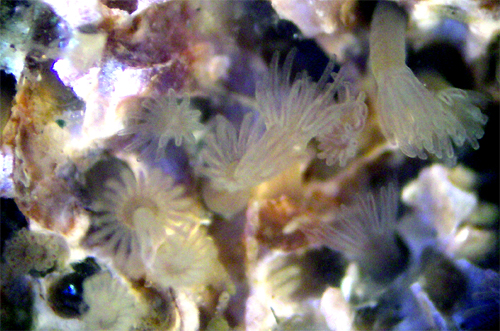|
Larva: not an Actinotrocha Silén, 1954 |
|
|
|
About the species name ovalis: | |

|
° References of the most recent publications
|
||||||
| Diagnosis | ||||||
| Last update: October 9, 1982
Extended specimens up to 15 mm, diameter 0,15-0,35 mm.
Sexual reproduction: hermaphroditic (or dioicious?); embryos brooded in the parental tube. Absence of nidamental glands and lophophoral organs. Asexual reproduction by transversal fission, by autotomised lophophores, by budding. Phoronis pallida burrows into empty and decayed mollusk and barnacle shells and carbonate rocks. Bathymetric range from 0 - 55 m, commonly between 20 and 50 m.
The distribution of Phoronis ovalis is represented below on the map. Type-locality: Inchkeith, Firth of Forth (UK) Last update: January 9, 2013>
|

Mamkaev Y. V., 2011. Phylum Phoronida. In: Illustrated Keys to Free-Living Invertebrates of Eurasian Arctic Seas and Adjacent Deep Waters, Buzhinskaja G. N. ed., Alaska Sea Grant College Program (Publisher), Vol . 2 [168 p.]. Ruesink J. L. & Trimble A. C., 2010. First report of Phoronis ovalis from Africa and its effect on mussel hosts. African Journal of Marine Science, 32 (1), 109-114. Grobe P. & T. Bartolomaeus, 2007. The coelomic origin and phylogenetic affinities of the Phoronida. 100. Jahresversammlung der Deutschen Zoologischen Gesellschaft (Köln, 2007), Abstract, p, 38. Gruhl A., Grobe P. & T. Bartolomaeus, 2005. Fine structure of the epistome in Phoronis ovalis: significance for the coelomic organization in Phoronida. Invertebr. Biol., 124 (4), 332-343. |
|
Sampled subtidally below a beach of Swakopmund (Namibia) in a mollusk shell of Perna perna
|




